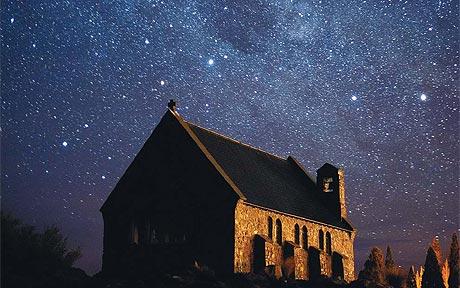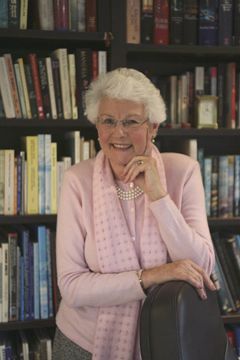The world reserve park in the sky concept – from the beginning


Prime minister John Key this week gave his backing to NZ’s world starlight reserve project. The feature below is a backgrounder to how the proposal came about.
If nothing else, former Cabinet minister Margaret Austin is utterly determined. Now well into her 70s, Austin is leading the New Zealand effort in seeking to have night skies recognised as significant to people and world heritage.
A key UNESCO world heritage committee meeting in Brasilia in July will confirm if the starry nights can be added to their Operational Guidelines.
Austin and her Tekapo Aoraki/Mt Cook- working party have begun a nationwide campaign to get people behind the Kiwi campaign for recognition.
She says a night sky reserve above the Mt John observatory at Tekapo increases the potential to provide night-time as well as day-time tourist attractions in the Mackenzie district. The interest and support of the people in the Mackenzie is critically important to the success of the project and we know they are behind it.
``We have the great advantage of having lighting ordinances already in place to control light pollution. My understanding is that they meet the international requirements,’’ Austin says.
``The potential to attract international visitors as a result of world heritage status cannot be underestimated. It means increased occupancy for accommodation, additional business for restaurants, cafes, arts and crafts and recreational activities and it creates an awareness of the importance of the stars as a significant part of human heritage which because of light pollution are no longer visible in many parts of the world. In addition we can plan events and educational activities to enhance the experience for visitors.
The Observatory at Mt John is New Zealand’s principal location for astronomical research and will continue this important work and contribute to knowledge and discoveries. Along with other initiatives there and at Mt Cook there is an ideal opportunity to engage further in educational activities for young people and visitors.’’
The genesis of the starlight project goes back to 2003 when Francesco Bandarin, director of the World Heritage Centre of UNESCO, proposed it was time to examine the relationship between monuments and astronomy at the World Heritage meeting in Suzhou, China in 2003.
Then at the Durban in 2005 the World Heritage Committee asked the director of the WHC further explore astronomy and world heritage as a means to promote, in particular, nominations which recognise and celebrate achievements in science.
Subsequently in proclaiming 2009 the International Year of Astronomy at UNESCO’s general conference in 2005 a fresh statement was endorsed: “The sky is an integral part of the environment perceived by humanity. Humankind has always observed the sky either to interpret it or understand the physical laws that govern the universe. This interest in astronomy has had profound implications for science, philosophy, religion, culture and our general conception of the universe.”
Many major developments in communications, navigation systems and even advanced medical imaging technologies have been due to the development of modern astronomy.
However Austin said the resource was under serious threat from uncurbed increase in light pollution, radio-electric disturbances and air pollution, all of which were having an impact on the quality of nocturnal observations of the skies in many parts of the world.
New Zealand took up the initiative almost eight years ago when the Mackenzie District Council included “maintaining the ability to view the night sky” in its district plan. Early in 2006 discussions took place in Tekapo to establish interest in the ``park in the night sky concept”. Local leader Graeme Murray became a driving force before helping involve Austin as the political leader of the group.
In April 2006 when she met Francesco Bandarin and other advisers in Paris seeking advice on the precedents and protocols for inscribing scientific and archeo-astronomical sites.
Numerous meetings in Paris, La Palma, Christchurch, Feurteventura, Rio de Janeiro and Seville in the last four years have resulted in the Tekapo - Aoraki/Mt Cook site being an example of an accessible Starlight Reserve for consideration because of its research, astro-tourism, natural landscape and bio-protection.
Austin says the public attention nationally and internationally since the NZ project got underway has been unprecedented and ``will undoubtedly have had an impact on tourism generally’’.
`` The review of the Canterbury management plan by the Department of Conservation provides a unique opportunity to draw on the already significant support for the starlight reserve proposal
Last year, the NZ project was warmly received by the International Year of Astronomy symposium in Paris and they were invited to present a case study at Spain’s Fuerteventura in March. This was followed by another UNESCO sponsored meeting on La Palma last November. Five sites were chosen as exemplars: Tekapo Aoraki/Mt Cook, Austria, La Palma, Chile and Hawaii.
``The end of 2009 sees us in a position of almost ready to present proposals to the World Heritage Committee at its meeting in Brasilia in 2010. We have almost achieved step one. We will strongly push our case this year to the WHC Committee, our Government and Canterbury University.
``In our favour, we have ease of accessibility, lighting ordinances already in place and it is critical we now have endorsement of the Government before the Brasilia meeting in June,’’ Austin says.
Recognition by the World Heritage Committee will put the Tekapo Aoraki/Mt Cook Starlight Reserve onto the international radar which has great impact on tourism bringing people to NZ and the region to view the stars. The potential to increase foreign exchange earnings through capitalising on night tourism as well as daytime activities is very great.
Lake Tekapo is a superb site with a pristine dark southern sky and views of the centre of the Milky Way galaxy and the Magellanic clouds, sites unknown in Europe. The Aoraki/Mt Cook – Tekapo area has exceptional unpolluted skies with very low light pollution because of the lighting ordinances which are nearly 30 years old.
Mt John above the Tekapo township is considered one of the most accessible observatories in the world. The observatory is home to six telescopes including the country's biggest telescope which measures 1.8m across and can observe 50 million stars each clear night.
But at the moment the New Zealand project is at the crossroads and July in Brasilia will decide the future.
Robert Williams, the current International Astronomy Union president, says the international year of astronomy 2009 may be over but, but it leaves an important legacy for starlight supporters to carry the baton. The groundwork has been laid for astronomers and enthusiasts around the world to use the momentum gained from 2009 to ensure that the universe is still to be discovered far into the future. In New Zealand Austin is carrying the torch.
Note: Martin Lord Rees, Astronomer Royal and President of the Royal Society London will be giving the (Lord Ernest) Rutherford Memorial lectures in NZ, one in Christchurch on March22 and the other in Wellington on March 2.
